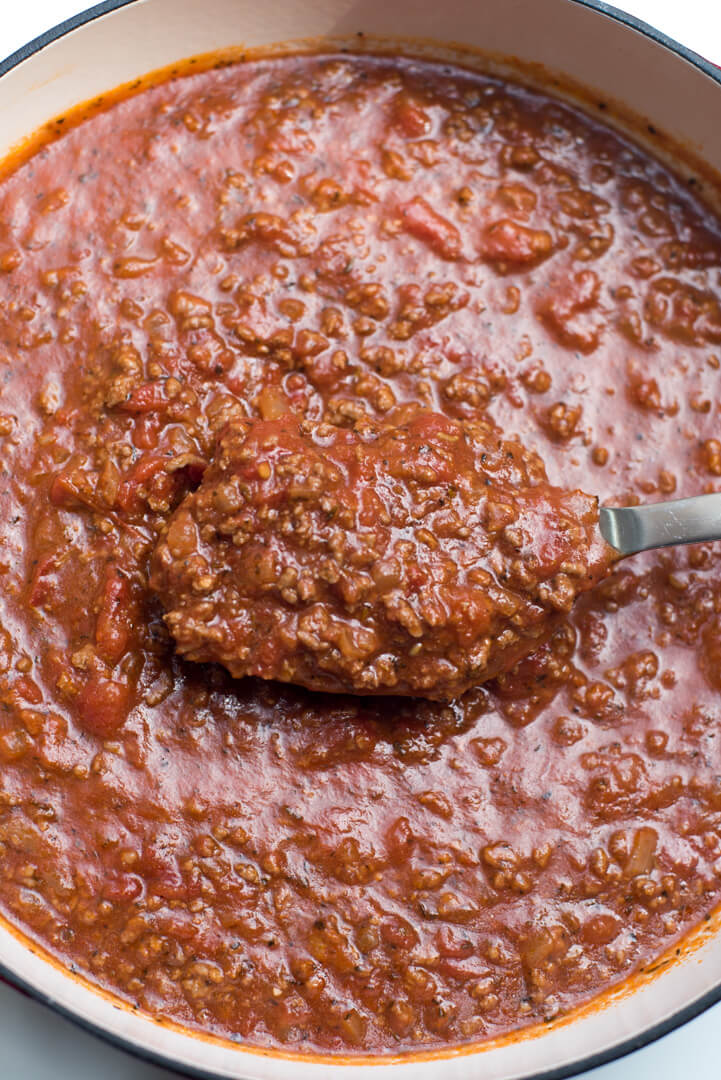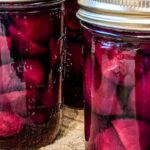Time: 15 minutes of preparation and 4 hours to cook Servings: 6
Italians are well known for their tasty pasta. In this recipe, we are going to learn how to make a delicious Italian spaghetti sauce. It makes life much easier when it is stored and served on top of your spaghetti. This is an exquisite dinner idea for you and your family.
The taste of this spaghetti sauce is really marvelous. It is very moist, thick and creamy. We use different types of tomatoes; tomato paste, roasted tomatoes and crushed tomatoes. For special flavor, we use different seasoning; Italian seasoning, salt, pepper and parsley. In order to have a tangy flavor, we also added garlic and sweet onion. In addition to this, the ground beef and the sausage makes this sauce very moist and prevent it from being dry. Do not worry about the sugar in this recipe. It plays an important role in evening out the taste of the sauce.
You can easily prepare this spaghetti sauce. You only need few clear steps that you will find below in the instructions section. Although this recipe takes 4 hours to cook on low, it actually takes only 15 minutes to prepare. Additionally, only few utensils are used. This makes this one of the recipes that do not make you sit in the kitchen for a long time.
This spaghetti sauce contains 493 calories, 29g of carbohydrates, 28 g of fat and 32 g of Protein. Each serving of this recipe also provides you with 5 g of Fiber, 18g of sugar, 7 mg of Iron, 1725 IU of vitamin A, 34 mg of Vitamin C, and 127 mg of Calcium. This delicious sauce is very nutritious.
Contents
INGREDIENTS:
- 1 pound spicy Italian sausage
- 1 pound lean ground beef
- 1 diced large sweet onion,
- 5 minced garlic cloves
- 2 tablespoons of granulated sugar
- 2 teaspoons of dried Italian seasoning
- 1 teaspoon kosher salt
- 1/2 teaspoon pepper
- 1/3 cup fresh chopped parsley
- 12 ounces tomato paste
- 15 ounces-can of diced fire roasted tomatoes
- 28 ounce-can of crushed tomatoes
- 1/2 cup of chicken broth
INSTRUCTIONS:
- Place a large pot or pan over medium-high heat.
- Add in the beef and the sausage to the pan and break it up into small pieces using a spoon.
- Stir in the onion and garlic and allow everything to cook.
- Once the meat is brown, drain off any excess fat.
- Lower the heat to medium, add in sugar, salt, the dry Italian seasoning, parsley and pepper.
- Add in the tomato paste and combine everything using a wooden spatula.
- Add in the diced tomatoes with their liquid, chicken broth and crushed tomatoes and combine everything.
- Allow the sauce to simmer and reduce the heat to low.
- Allow it to simmer again for a minimum of an hour and a maximum of 4 hours.
- You can enjoy it immediately with spaghetti. You can also refrigerate or freeze this sauce for later (check how below)
Notes:
- It is recommended to make this sauce in the morning to give it time to simmer throughout the day (for up to 4 hours). The longer it simmers and cooks, the better.
- Sugar plays an important role in this sauce. It lowers the acidity of tomatoes and balances the taste.
Ideas for spaghetti sauce leftovers:
- You can spread it over garlic bread.
- You can use it for a quick skillet lasagna.
How to serve?
Place it on top of your spaghetti and enjoy!
How to store?
- You can store this sauce in an airtight container in the refrigerator for a maximum of 3 days.
- This spaghetti sauce can also be reserved in the freezer. Just keep it in an airtight container for a maximum of 4 months.
- You can definitely make it ahead of time. Just store it appropriately.





Italian people call it gravy
Can this be canned?
Yes, spaghetti sauce can be canned, but it’s essential to follow safe canning practices to ensure the product remains safe to eat and retains its flavor. Here’s a basic guide on how to can spaghetti sauce:
1. Acidification: Since tomatoes are on the borderline between high-acid and low-acid foods, it’s recommended to add a form of acid to make them more acidic and safer for water bath canning. You can add either 2 tablespoons of bottled lemon juice or 1/2 teaspoon of citric acid per quart of sauce. This ensures safety against botulism when canning.
2. Preparing Jars: Sterilize your canning jars by boiling them in a large pot of water for 10 minutes.
3. Filling Jars: Fill the hot jars with the hot spaghetti sauce, leaving about 1/2 inch of headspace. Remove any air bubbles with a spatula or bubble remover.
4. Sealing: Wipe the rim of the jars with a clean, damp cloth to remove any residue. Place a sterilized lid on top and screw on a ring until it’s fingertip-tight.
5. Water Bath Canning: Process the jars in a water bath canner. The water should cover the jars by at least one inch. Process pint jars for 35 minutes and quart jars for 40 minutes. This timing starts once the water returns to a boil.
6. Cooling: Once processed, remove the jars and let them cool on a clean towel or wooden board for 12-24 hours. You’ll likely hear a “pop” sound which indicates the jars are sealing.
7. Check Seals: Once cooled, check that the jars have sealed properly. The lids should not flex up and down when pressed in the center.
8. Store: Store in a cool, dark place. Wait at least a week before using, to let the flavors meld. Properly canned, they should be good for at least a year.
Note: If you’re new to canning, consider reading up more on the topic or consulting with an expert before you start. Safety is crucial when it comes to preserving foods.
Enjoy your homemade spaghetti sauce anytime!
Once you cook the beef, sausage, onion and garlic; can you mix all the other ingredients and finish cooking in a crockpot? If so, what temp would you suggest, H or L and how long? Thanks